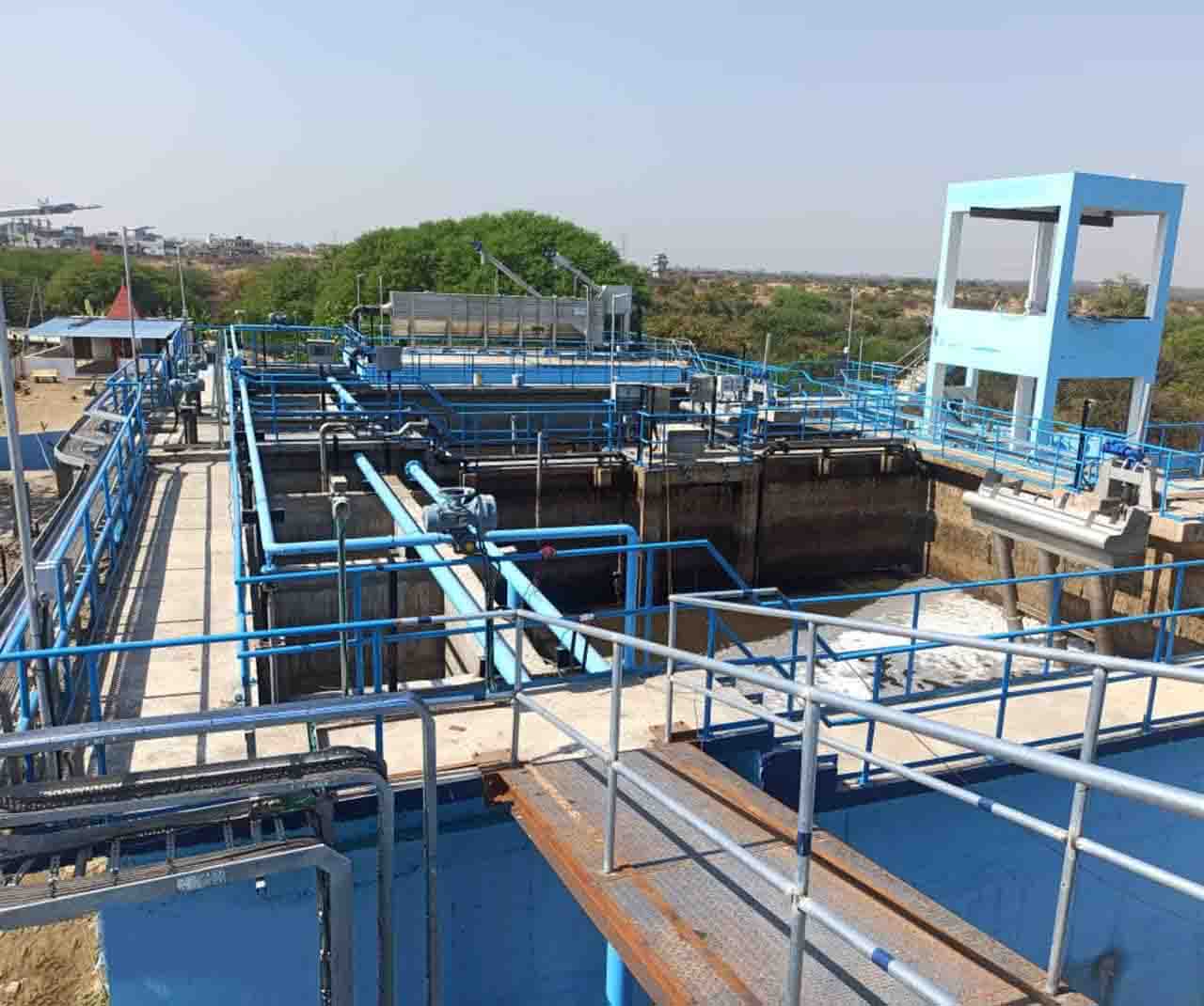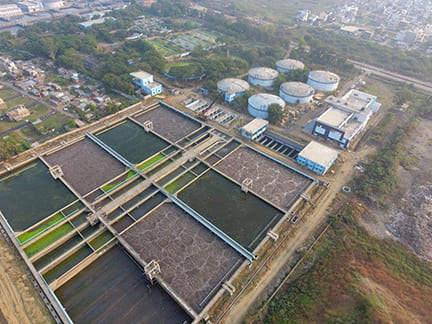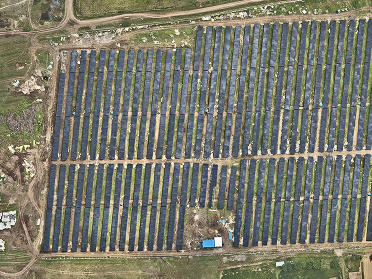Fundamentally, India has adequate water availability even for its increased population unlike few Gulf countries which are water scarce. Even if the Smart Cities in India are considered, 84 of the 100 chosen cities have more than sufficient water with respect to the international norm of 135 litre per day per person. Still Indian towns are not able to provide sufficient water to its citizens. The water supply is inadequate (2 to 6 hours a day), irregular (timings / days of supply are not fixed), water quality at times is not up to the standard, low water pressure and so citizens have to face lots of hassles. Ground water extraction is still rampant in some states of India and this water is not safe for drinking. There are some areas in almost all the towns where only source of water is tankers. The root cause of this menace is the missing accountability to manage water efficiently.

So the good news is that the water available has always been enough but there is a failure to manage it by not addressing maintenance part. Billions of rupees have been invested in setting up new systems but old assets are not maintained adequately. Accountability of this precious resource is missing since bulk water flow meters are not installed in many towns. Nor did public utilities insist on measured delivery to the consumers by having house meters the penetration of which is as low as 4%. This has resulted into over 50% losses from the water networks without any knowledge about the severity of problem due to non-metering . Sustainable, Efficient and Accountable model with People participation for water management is what is needed, and is very much implementable.
VEL Approach – The entire water supply system for a town needs to be looked into in a more holistic and integrated manner. The current water demand for the town and the realistic projections over next 30 years should be the design basis. Localised zonal demands and demand based hydraulic modelling forms the engineering basis to design the water supply network for the towns. Since the existing pipelines are pretty old and the maps are not generally available, laying a new pipeline could be a better approach than rehabilitation of existing pipeline. House service connection at the consumer end with installation of reliable water meter completes the water network. DMAs are formed to ensure dividing the large network into smaller identifiable metering areas. So any leak can be detected effectively within any geography. Once proper network is commissioned, it needs to be maintained by a single operator right from WTPs to consumer taps. Operator must own the responsibility of reducing Non Revenue water (losses) by fixing the leaks and illegal connections and to improve the water supply hours ultimately reaching to 24x7 continuous, pressurised and clean water supply.
The idea is not only to maintain adequate 24x7 water supply but also bring awareness in consumers to reduce the demand by avoiding wastages due to leakages and excess usage.
In country like India where water is socially sensitive issue, it must be ensured that the water is provided to the poor families at a very reasonable rate. Volumetric tariff with cross subsidisation forms an important part of water supply value chain. All these water management efforts must be “Citizens inclusive” putting them at the centre of plan. Citizens need to be taken into confidence through effective communication at each of the project management steps.
Opportunity
Indian cities and towns are at different stages of evolution as far as water supply networks are concerned. Government of India has launched multiple programs to upgrade the networks in urban and rural geographies.
Smart Cities Program
100 cities are identified either for green field or area based development to upgrade urban amenities with strong focus on improvement of water supply.
AMRUT Mission 1 and 2
500 small to medium cities are identified and projects are launched to improve various urban services along with water supply network, sewerage networks and solid waste collection and processing.
Jal Jeevan Mission (Nal se Jal)
Government of India launched a very ambitious program to connect each village household with treated surface water. Multiple projects are launched in different states for improving rural water supply through Jal Jivan Mission.
Investment of more than 300,000 Crs (USD 42 Bn) is expected over a period of next 5 years in water supply sector.
State of wastewater treatment in India is far inferior as compare to many of the developed countries. Wastewater generated in urban India is mostly discharged in the open leading to unhygienic conditions and environmental pollution which poses significant health and ecological problems. Wastewater collection and treatment are part of the full sanitation cycle and influence public health and the environment. We see water bodies like lakes, rivers, wells contaminated due to sewage. Sewage Treatment in India is vested with ULBs. Because of financial constraints, the sewage treatment is not always the top priority for the ULBs. Urban India generates more than 60,000 MLD of sewage and hardly 20,000 MLD is getting treated and the balance goes to the water bodies untreated. It is estimated that 21% of health problems are due to water borne diseases.

The person days lost due to water borne diseases is approx. 100 Mn per year. Untreated sewage contaminating water bodies is one of the key reasons for such high percentage of water borne diseases.
VEL Approach
Augmenting sewage treatment infrastructure is a national priority. India needs to build the sewage treatment infrastructure through cost effective technologies that assure desired outlet parameters on a sustainable basis. One of the current challenges Indian towns are facing is the inadequate sewerage network. However the sewage treatment in India need not wait for the sewerage network to get complete. Sewage flowing through drains or nallahs needs to be tapped and brought to treatment plant for treatment. There is also need for making operator who constructs the STPs responsible for its operations for at least 15 years. Long term O&M period helps proper operations of STPs.
Opportunity
Government of India has launched various programs to augment sewage treatment infrastructure.
Swachh Bharat
The program focuses on solid waste processing and sewage treatment.
National Mission for Clean Ganga
This mission focuses on building
STPs across the river Ganga basin including its tributaries.
AMRUT 1 and 2
The program in both phases focuses on improving
urban services in 500+ towns.
Total investment of 2,60,000 Crs (USD 36 Bn) expected in the
sewerage sector.
There has been a thrust on reuse of municipal treated sewage water in the developed countries. Most of western developed economies are reusing the treated water and the percentage of reuse water is ranging from 5 to 25 %. There are multiple wins in reusing the treated water.
Fresh water can be swapped with treated water for non-potable use in Industry ( Power Stateions etc) and this fresh water can then be used either for citizens for drinking or for agriculture

Reuse ensures quality treatment of sewage since reuse user is conscious about the quality of water.
Revenue from sell of treated water helps in developing circular economy
Treated water offers secured water source for the end user
VEL Approach – In a water scarce country like India, the reuse of municipal treated sewage water is all the more relevant. The industries with large water demand is the ideal candidates for reuse. Power plants which consumes more than 70% of the industrial water have already been asked by Govt of India to use treated water if within 50 kms of the larger towns. Other industries like Steel, Oil Refineries, paper, textile etc. can also be offered treated sewage water. Once industries start using treated water, the uninterrupted supply of required quality water needs to be ensured. So, a right project framework is needed for Reuse of water with the Industries. Projects on Public Private Partnership (PPPs) model (HAM) aptly addresses the issues involved in supply of treated water. It brings in private investment and competence in the sector thereby reducing reliance on government funding. The skin in the game from the private operator also ensures quality and quantity commitment needed by the industry. It also reduces the overall time of project execution and offers a much needed service to the industries during O&M period.
Opportunity
Power plants in India can reuse almost 6,000 MLD of treated water thereby needing an investment of Rs. 30,000 Crs.
The other industries too can reuse a large volume of treated water thereby facilitating much more the private investment in the sector.
Indian water utilities have developed water assets worth billions of Rupees. These assets were developed over period of last two to three decades and comprises of Treatment plants, distribution network, electro-mechanical parts and much more. The assets so developed were as per then prevalent standards. Now many of these assets are due for replacement. Many of them were built on old technologies and needs upgradation. Advancement in SCADA and other automation technologies can also improve the efficiency of the assets.

These advance SCADA systems can analyse the machine data and provide useful information remotely. The SCADA information can itself take automatic actions or can provide useful information for manual decision making.
VEL Approach – Upgradation, automation and long term O&M of the water assets is need in the water sector. STPs those were developed with old quality standards need upgradation as per new NGT norms. Many city level water networks can be upgraded by introducing flow meters with connectivity and then connecting it with SCADA system. VEL has a dedicated business unit to cater to these specific requirement of the water sector and acquiring large number of water asset under its portfolio.
India has the world’s second-largest area of agricultural land. With more than half of the population relying on farming for their livelihood, agriculture remains central to the nation’s economy and food security. The sector contributes nearly 18% to GDP and employs over 50% of the workforce. Yet, behind these numbers lies a reality of persistent challenges. Low productivity, unreliable irrigation, and inadequate infrastructure often leave farmers vulnerable to the vagaries of the monsoon.

VEL Approach VEL has forayed into the field of irrigation with a clear mission: to make agricultural water use more efficient through piped supply systems. Our first project under the Pradhan Mantri Krishi Sinchayee Yojana (PMKSY) is in Bodwad Taluka, Jalgaon district of Maharashtra. Here, we are bringing assured irrigation to a Culturable Command Area of 20,887 hectares, touching the lives of farmers across 41 villages. For many of these communities, this marks the shift from dependence on erratic rainfall to the security of a steady, equitable water supply.
Opportunity The irrigation sector is on the cusp of significant expansion. By Fiscal 2025, the share of irrigated land is projected to reach ~55%, driving sectoral value to ₹6,500–7,500 billion. The strong correlation between irrigation coverage and crop yield underpins this growth trajectory.
Pradhan Mantri Krishi Sinchayee Yojana (PMKSY) Launched in 2015, PMKSY is the government’s flagship programme for strengthening irrigation. It provides an integrated solution across the irrigation value chain, covering water resource development, distribution networks, efficient on-farm application, and extension services. The scheme brings together central, state, and district-level investments under a unified framework through comprehensive irrigation plans, ensuring convergence and better outcomes.
India is undergoing one of the world’s largest clean energy transitions. The government has set an ambitious target of achieving 500 GW of installed electricity capacity from non-fossil sources by 2030. To meet this goal, it plans to add 50 GW of renewable energy capacity every year for the next five years.
Beyond climate goals, renewable energy is creating tangible benefits for people and communities. Rural areas are gaining access to electricity through decentralized solar systems. Farmers are finding new sources of income by leasing land for solar farms or installing solar pumps that reduce dependence on diesel. For India, renewable energy is more than an environmental imperative - it is an economic and social opportunity.

VEL’s Approach At VEL, we see renewable energy as a natural extension of our commitment to building sustainable and resilient solutions for the future. We forayed into this space by beginning the development of solar power projects across Maharashtra, spanning six districts. Together, these projects will generate 201 MW (AC) of clean energy. Through power purchase agreements with the Maharashtra State Electricity Distribution Company Limited, we have secured a 25-year commitment to supply clean power under the PM-KUSUM Scheme.
PM-KUSUM Scheme The PM-KUSUM Scheme aims to reduce reliance on diesel in the farm sector while enhancing farmer incomes. It provides central government subsidies of 30% to 50% of the total cost for installing standalone solar pumps and solarizing existing grid-connected agricultural pumps. In addition, farmers can install grid-connected solar plants of up to 2 MW on barren or fallow land and sell electricity to local DISCOMs at state-regulated tariffs. The scheme is implemented through designated state government departments.